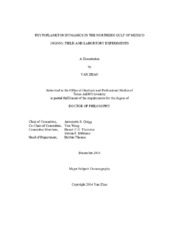| dc.description.abstract | The freshwater inflow of the Mississippi-Atchafalaya River system and the local circulation patterns result in nutrient enriched waters in the Northern Gulf of Mexico (NGOM) in spring, which fuels phytoplankton blooms, increases the vertical transportation of organic matters and initiates the bottom hypoxia. In 2012, we conducted two research cruises in the NGOM in April and August, in order to investigate phytoplankton diel cycles and nutrient limitations. Our results indicated that the diel rhythms of phytoplankton photosynthetic physiology and carbon fixation were regulated by light penetration, the mixed layer depth and phytoplankton community structure. Further, phytoplankton in the NGOM responded to light stress by means of fast (secs-mins) and long-term (days-weeks) photoacclimation. At our research stations, nitrogen (N) limitation was diagnosed by nutrient enrichment bioassays. The supplement of N not only stimulated phytoplankton biomass and restored the photosynthesis but also changed the community structure with a shift mainly from the large cells to small cells. This part of study provided new empirical data on the phytoplankton dynamics in the NGOM, filled some former studies’ gaps including the diel changes of photosynthesis and community structure shift under nutrient pulses. Based on the results of field studies, a series of laboratory experiments were performed to test the effect of nutrient fluctuations on the diatom Phaeodactylum tricornutum and the coccolithiophore Emiliana huxleyi. The results indicated that E. huxleyi was more competitive than P. tricornutum under N and P starvation. For both species, cell growth was more limited by P starvation, while photosynthetic apparatus and cellular constituents were more impaired by N starvation. The photosynthetic functions were less impaired and the photoprotective effects were more active in E. huxleyi than P. tricornutum. Also, photosynthetic functions and cellular constituents of N starved cells in both species showed recovery within 24 hours after supplementing nitrate (N). P. tricornutum prioritized recovery of photosynthesis and cell divisions over cell constituents, giving this species a competitive advantage for N-pulses. The performance of the two species was consistent with the findings in field studies. | en |


